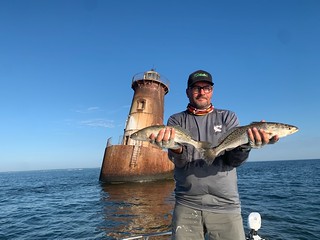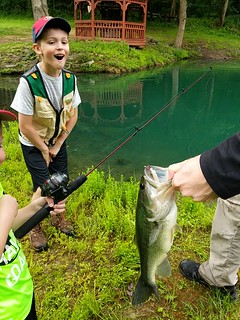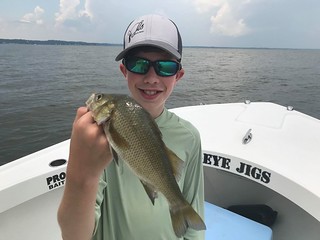Maryland Fishing Report – July 22

Fhinn Zeender-Lawrence caught this nice pumpkinseed, along with croaker and catfish this weekend with bloodworms off a dock in Edgewater. Photo by Nathan Zeender
The weather is putting a lot of heat-related stress on both anglers and the summer striped bass population. We ask anglers to focus their fishing on early morning hours, or switch to other species during the heat wave. Throughout Maryland’s warmest months, the department’s online striped bass fishing advisory forecast provides a seven-day outlook to help anglers reduce striped bass mortality during the summer fishing season.
On July 23 at noon the Maryland Department of Natural Resources is hosting a webinar on summer fishing conditions, giving striped bass a break, and targeting alternative and invasive species. The Maryland Fishing Report team — including Maryland recreational fisheries specialist Erik Zlokovitz, Tom Parham of DNR’s Eyes on the Bay, and moderator Eric Wilson of Fishing and Boating Services — will discuss summer fishing opportunities in the Chesapeake Bay. Additionally, Dr. Joe Love will tell you everything you need to know about snakeheads. You can join the discussion through Google meets or by phone at 1-443-671-4706, and use the PIN: 674 636 739. Details are also found on the department’s online calendar.
And don’t forget to take the kids fishing, even if it’s a short trip to a local dock. All anglers can feel free to send any pictures of your catches to fishingreports.dnr@maryland.gov for possible inclusion in our fishing report or the daily Angler’s Log.
Expect a repeat of the past few weeks with warm, sunny skies, a chance of thunderstorms, and low winds most of the week. Main Chesapeake Bay surface water temperatures have risen to the mid 80s. Long-term DNR water monitoring shows that peak water temperatures occur during this period of July. These warm waters and corresponding low oxygen areas in the bay are appearing from Swan Point down to the mouth of the Potomac.
These hot, calm conditions will continue to warm surface waters and limit oxygen being recharged to the deeper waters by wind mixing, increasing the chance of algal blooms. This will result in gamefish remaining at similar locations on cooler river mouths or main bay structure but moving to slightly shallower depths, just above the Don’t Fish Below this Depth mark and maximum suitable oxygen depth, in the coolest water available.
The coolest, oxygenated water is found in the deeper waters from Pooles Island down to the Virginia state line. The other way to find cooler water is to fish the shallows at first light when surface water temperatures can be several degrees cooler. As always, best fishing areas could be further refined by intersecting these cool, oxygenated areas with underwater points, hard bottom, drop-offs, and large schools of baitfish.
Expect reduced water clarity from algal blooms along the upper western shore rivers including the Northeast, Sassafras, Bush, Back, and Patapsco rivers; plus the lower Chester River down to the Bay Bridge, and the upper Patuxent and Wicomico rivers. To see the latest water clarity conditions, check Eyes on the Bay Satellite Maps.
Expect normal flows all week from most of Maryland’s rivers and streams. There will be above average tidal currents through Saturday as a result of the July 21 new moon.
For more detailed and up-to-date fishing conditions in your area of the bay, be sure to check out Click Before You Cast. Get regular updates on Maryland’s waters sent to your inbox with our Eyes on the Bay newsletter. Sign up online.
The Conowingo Dam remains on a late afternoon power generation water release, with low flow in the mornings due to hot and dry conditions. The area below the dam is one of the best places in Maryland to target large flathead catfish; fish up to 55 pounds have been caught here in the past two years. Fishing or blue catfish continues to be very good at the dam, in the lower Susquehanna River, and other tidal rivers. Channel catfish are abundant in all of the region’s tidal rivers. Catfish can be caught on fresh cut baits, clam snouts, and a variety of other baits.
White perch are providing reliable action in the upper bay during these hot summer months. They are spread throughout the entire Chesapeake Bay and tributaries, and populations are abundant. Many anglers are finding a lot of small perch in some areas but a few big fish can be culled from the school. The usual small spinners and 1/16 to 1/8-ounce lead heads with Mr. Twister grubs on light spinning tackle will produce results. Pieces of bloodworm, grass shrimp, wild seafood shrimp, and small minnows are all good baits. Medium-sized minnows fished under a bobber around shoreline structure will often catch a large grade of perch.
The usual bottom fishing areas for saltwater panfish — spot, perch and croaker — should be productive the next few weeks. Spot and white perch can be found on hard bottom areas or shoals off Sandy Point State Park beach, the mouth of the Magothy, and the shallow ends of the Bay Bridge. White perch can also be found at the Snake Reef, Belvidere Shoal, and the 7-foot and 9-foot knolls. A few small croaker have been caught in the Severn River, South River, and other areas, but most are sub-legal.
We are asking anglers to avoid targeting striped bass during this heat wave, with 95-100 degree air temperatures. However, if you do target striped bass, remember that you must use non-offset circle hooks at all time when chumming or livelining. We also advise using lures with single barbless hooks to make releasing fish easier, and care must be taken when handling fish. Never use a rag while unhooking a striped bass — this will rub off their protective slime layer, making them more vulnerable to the summer combination of heat stress and disease.

Eric Packard caught these two spotted sea trout near the Sharps Island lighthouse. Photo courtesy of Eric Packard
Bottom fishing action for both spot and perch can be found at Hacketts and Thomas points on shell bottom and bars, as well as around Eastern Bay, Poplar Island, and the Severn and Choptank rivers. Small bluefish and spanish mackerel should be moving into the area soon, with the combination of hot and dry weather and salinities being relatively high. Anglers are hoping for a repeat of last year’s hot action on Spanish mackerel which extended all the way to the upper bay.
Speckled trout action continues from the Choptank River south along the Dorchester County shorelines, and down into the Crisfield area marsh shorelines and cuts. Grass beds in 3-5 feet of water and stump fields are excellent places to cast topwater lures and swim shads. Zara Spooks, Gulp plastics, and soft plastics in pearl or white with sparkles are popular. The structure around Sharps Island lighthouse is a popular spot.
Fishing for white perch in the shallower shoreline areas should be steady from now into September. Shoreline structure such as bulkheads, submerged rocks, fallen trees, and riprap are good areas to cast small spinners, spinnerbaits, and jigs. White perch and spot can also be caught off of docks and piers in 5-10 feet of water with a simple one-hook or two-hook bottom rig baited with pieces of soft crab, bloodworm, or grass shrimp. Synthetic bloodworm-flavored fishbites also work well.
A mix of blue and channel catfish should continue to provide steady action anglers fishing with cut bait, chicken livers, soft peeler crabs, and other baits in most of the tidal rivers within the region. Channel catfish can be found in every tidal river, and blue catfish are found mostly in the Choptank and Nanticoke rivers.

Jason Bozman holds a cobia caught while fishing with his brother Kevin. Photo by Travis Long
Cobia fishing has been good this summer at the Middle Grounds, the Target Ship, the Mud Leads, and Point Lookout. The traditional methods are chumming and fishing with cut bait or live eels. In past years, anglers have also caught large cobia with other live baits such as spot and small bluefish. Sight fishing with live eels or large soft plastics on a lead head jig is a trending method that started in Virginia. This requires using an elevated platform to spot fish, and polarized sunglasses to cut through the glare on the water.
Trolling spoons and hoses (surgical tube lures) will produce both cobia and large drum around the Target ship area, with bluefish in the mix. Brittany Growe had a thrill when she hooked an estimated 6 foot long tarpon on a trolled spoon south of the Target Ship. She fought it all the way to the boat, and the hook pulled after the fish was leadered, making this an official catch and release of a tarpon! This is an extremely rare event in the Maryland portion of the bay. Large red drum are also being caught and released by light tackle jiggers with soft plastics.
Small bluefish are moving into the region; they are running about 1 pound, which is fun for the kids and a perfect eating size, whether fresh or smoked. A reminder that the daily limit for 2020 is 3 bluefish per day for anglers fishing from private boats or shore, and 5 bluefish per day when fishing from a charter boat. Spanish mackerel should keep moving into the lower bay and are being caught by fast trolling — about 7 knots is the target speed — with small Drone or Clark spoons.
Spot and white perch should provide steady bottom fishing action in the hard bottom areas of the lower Patuxent River, Honga River, and off Hoopers Island. Pieces of bloodworm on a bottom rig is the best bait for spot.
The shallow-water fishing for speckled trout continues with topwater and soft paddletail baits near shallow grass beds along the Eastern Shore marshes. Zara Spooks work over grass beds and in stump fields, but reports show soft plastics and paddletails working best over deeper grass, shoreline structure, rocks. riprap, wood, and stump fields. The best speckled trout fishing is occurring along the marshes of the Pocomoke and Tangier sounds up to Hoopers Island.
There is some action for bottom fish and small bluefish along the western shore and Point Lookout area and into the lower Potomac River. Also be ready with metal lures in case Spanish mackerel show up on the surface. Striped bass can often be part of the mix, however, anglers need to be aware that the main stem of the Potomac River is closed to all striped bass fishing from July 7 to Aug. 20 by order of the Potomac River Fisheries Commission.
Recreational crabbing should improve as we get into late July and early August, with more crabs growing to legal size. The middle and lower bay offers the best opportunity to catch a bushel of crabs per outing. Trotlining at dawn is the best method, and razor clams tend to be the most popular bait in recent seasons. Work the 12-foot to 15-foot edges to find the crabs.

Dylan Boggs caught this 1.65-pound largemouth bass in a farm pond in Clarksburg. Photo by Bruce Fraser
With hot and dry conditions forecast for the next week or two, we expect trout streams in western Maryland to continue running low and clear. As usual, this will require finesse fly fishing techniques with long casts and light tippets. Small terrestrial fly patterns such as ants, beetles, and hoppers are good choices.
The upper Potomac River will continue running low and warm until weather patterns change. Target fast moving and deeper waters for smallmouth bass and cast grubs, small crankbaits, and tubes. There is also some topwater fishing along grass edges and shallows with buzzbaits and poppers at dawn and dusk.

Alexis Young caught this 31-inch snakehead in Blackwater Refuge on July 20. Photo courtesy of Alexis Young
Anglers should use caution when targeting, catching, and handling muskies. As water temperatures in the river rise, the resident muskies will be stressed by warm water temperatures and will be resting in slightly cooler waters in feeder creeks. In these conditions muskies cannot survive catch-and-release stress and should not be targeted.
Carp should provide steady summer fun in the upper Potomac, C&O Canal, and various ponds with the traditional baits of scented dough ball baits or corn. Fly casters can catch carp with purple flies that resemble mulberries in areas where the berries fall into the water from overhanging branches.
Farm ponds, reservoirs, rivers, and impoundments offer fun fishing for largemouth bass. Ponds and small lakes can be fished from shore with a variety of weedless soft plastics, including plastic worms, flukes, and lizards in grass, lily pads, or near sunken wood structure.
For anglers targeting northern snakeheads, bass lures such as buzzbaits and frogs are excellent baits to cast over thick grass. Chatterbaits and paddle tails will also produce snakeheads. The tributaries of the tidal Potomac, Patuxent, Patapsco, and other tidal rivers around the Chesapeake have expanding populations of northern snakeheads. For anglers targeting snakehead in central Maryland, try Little Seneca Lake at Blackhills Regional Park. Department biologists first documented a snakehead population in the lake in May 2019 after receiving reports of sightings by anglers. Snakeheads have been observed close to the bank even during the heat of the day. On the Eastern Shore, the Dorchester County tidal backwaters — tributaries to the Nanticoke and Wicomico — are consistent hotspots.
Blue catfish are always a good bet for anglers using cut bait in the Fort Washington area of the Potomac. Good places for blue catfish in the Patuxent River are along steep channel edges above Jacksons Landing, Jug Bay, and the mouth of Western Branch.

During the recent Ocean City Marlin Club “Kids Classic” tournament, Jake Hunter landed this awesome, 25.5-pound bull dolphin to hold First Place in the Dolphin Category.
The big story this week is the chunk bite on yellowfin tuna at inshore lumps such as the Hot Dog and the Rockpile. Marlin and dolphinfish are being caught at the canyons, such as Washington, Norfolk, and Poormans.
Effective Aug. 17, NOAA Fisheries requires private recreational tilefish vessels in the Mid-Atlantic to get permits and file catch reports. This action is being taken to better characterize and monitor the recreational fisheries for both blueline tilefish and golden tilefish. Get your federal private recreational tilefish vessel permit through the NOAA Fisheries website. Call 978-282-8438 for questions about the permitting process. Private recreational tilefish anglers must also fill out and submit an electronic vessel trip report within 24 hours of returning to port for trips where tilefish were targeted or retained.
Anglers fishing near shore or in the surf are reminded to use caution when handling sharks. Do not drag them high up on the sand. Dusky and sandbar sharks look similar, and both sharks are prohibited from harvest. If you cannot identify a shark, let it go in the water. State and federal regulations require shark anglers to use corrodible, non-stainless circle hooks except when fishing with artificial flies and lures, and any shark that is not being kept is to be released in the water. Anglers must have a device capable of quickly cutting either the leader or the hook.
Also, any harvested bluefin tuna, billfish, swordfish, or shark (except spiny dogfish) must be reported via the Catch Card Census before it is moved from a boat or point of landing, to be in compliance with state and federal regulations. Catch cards and tags are available at tackle shops, marinas, and kiosks around Ocean City, and online. Please use the kiosk at the Colonel Jack Taylor Boathouse located in west Ocean City when businesses are closed. Simply fill out the card found in the kiosk and tear off the receipt on the edge of the card, and leave the card in the kiosk. Identification and compliance information is available from the National Oceanic and Atmospheric Administration.
“Most of the world is covered by water. A fisherman’s job is simple: Pick out the best parts,” — Charles Waterman
This week’s Maryland Fishing Report is written and compiled by Erik Zlokovitz, Maryland Department of Natural Resources recreational fisheries specialist.
Click Before You Cast is written by Tidewater Ecosystem Assessment Director Tom Parham.
This report is now available on your Amazon Echo device — just ask Alexa to “open Maryland Fishing Report.”



 1-888-373-7888
1-888-373-7888 233733
233733